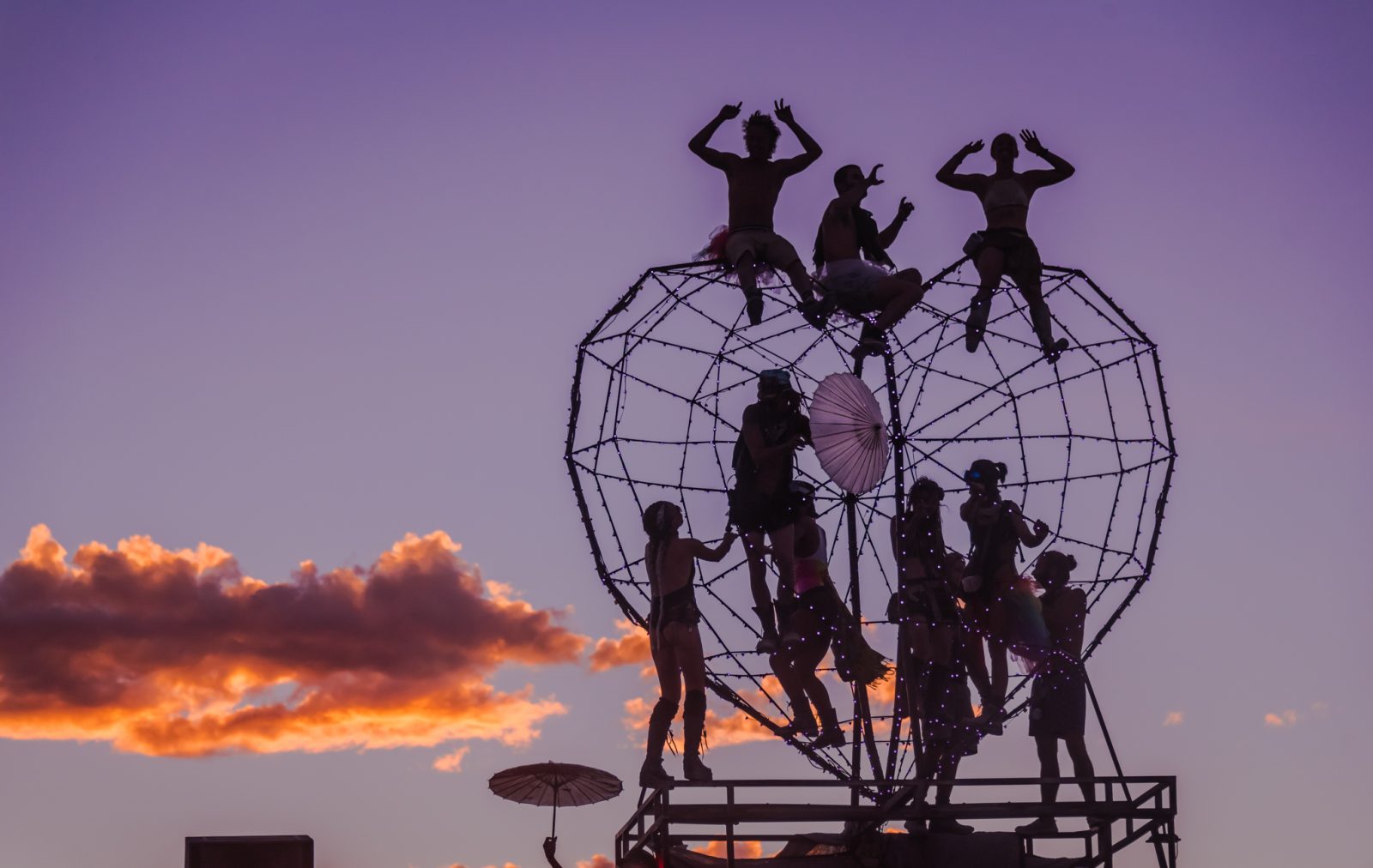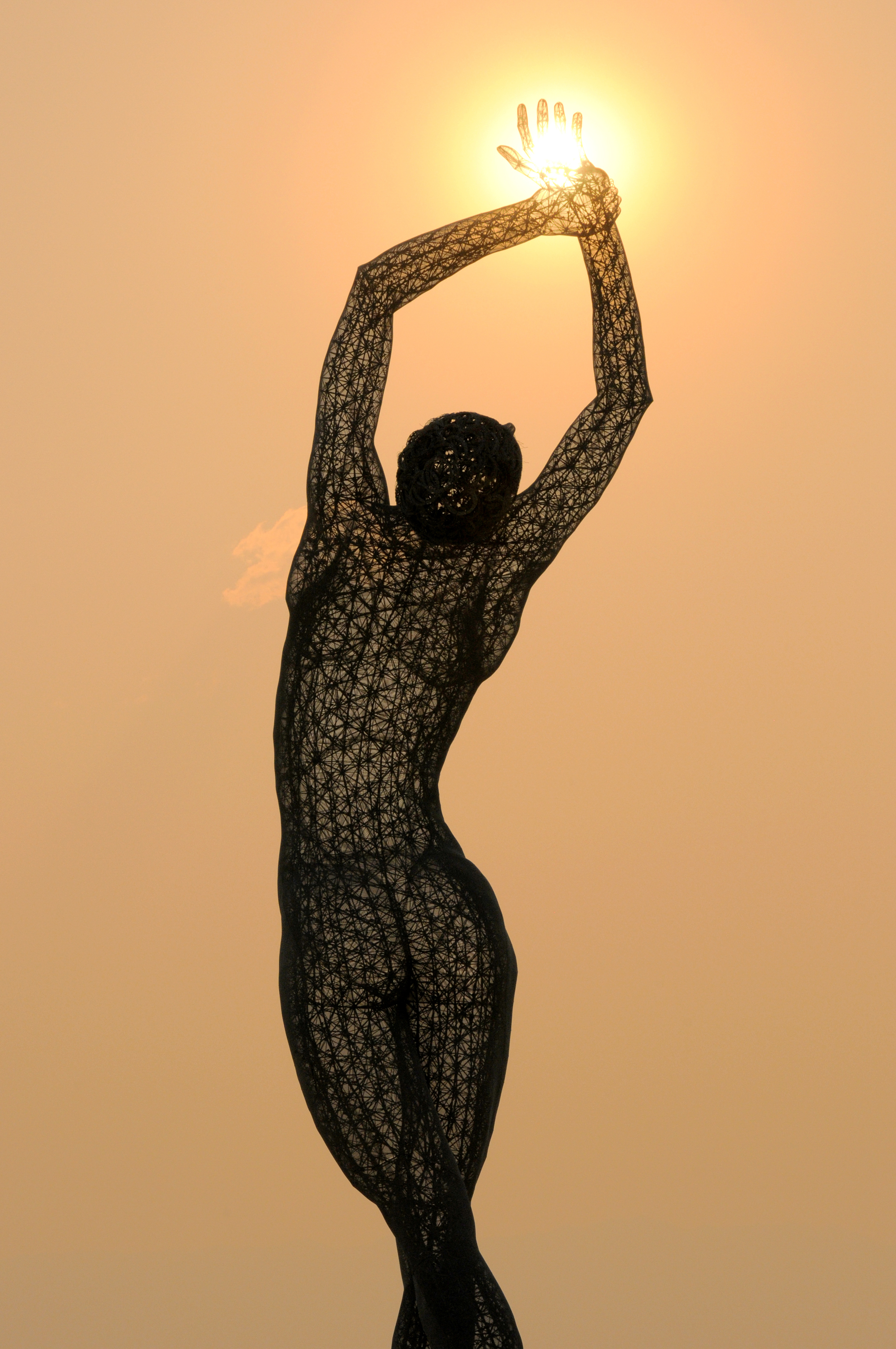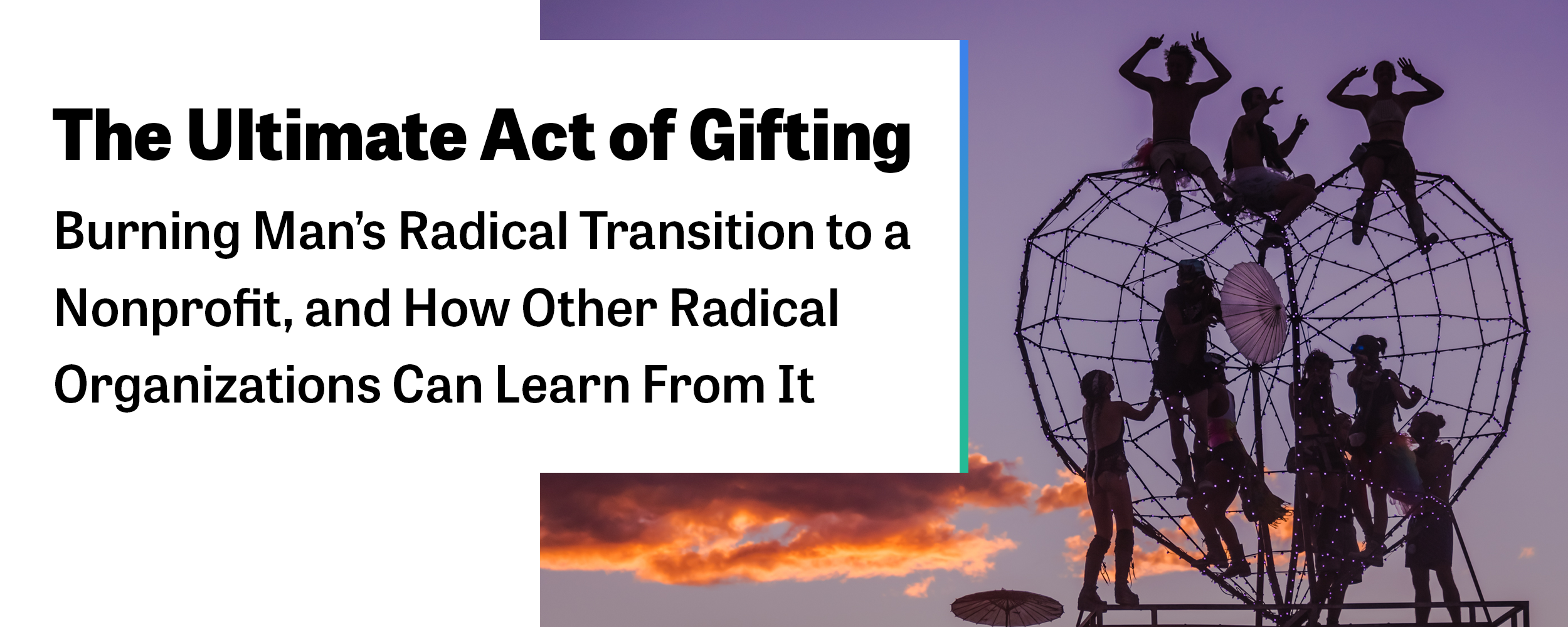
Photo of the Robot Heart art car at Burning Man by Tom Stahl
“After 25 years of tending our garden in the desert, we now have the means to cultivate its culture worldwide.”
— Larry Harvey, co-founder of Burning Man
On April 28th, 2018, Burning Man founder Larry Harvey passed away. He was 70 years old. By the time of his passing, Burning Man had largely transitioned from a body of several organizations, both nonprofit and for-profit, to a more unified nonprofit structure known as the Burning Man Project (BMP).
The original 1986 event, where Harvey built and burned a wooden man on San Francisco’s Baker Beach, drew only a small gathering. Now, Burning Man draws tens of thousands of participants from around the world. Together they build a temporary city, Black Rock City, which becomes the sixth-largest city in Nevada once a year, complete with its own airport and post office. The city is built in a desert (called “the playa”), so participants must bring their own shelter, food, water, power, and everything they need to survive in the sometimes extreme conditions — only to have the city be completely dismantled afterwards, fulfilling Burning Man’s commitment to “Leave No Trace” until the following year’s event.
The challenges of scaling this radical, alternative, grassroots community have been prodigious, particularly as Burner culture now has global reach, with many affiliated but separate regional events that happen throughout the year in places as far away as the Netherlands, South Africa, China, Argentina, and Ukraine. Affiliated organizations also now exist on a global scale, such as Burners Without Borders, which was created in the aftermath of Hurricane Katrina to address areas where volunteerism is needed in times of natural disaster.
Earlier this year, I published a Berkeley-Haas business school case study about Burning Man’s transition to its current nonprofit form, based on hours of interviews generously given by Burning Man’s founders — including Larry Harvey, Michael Mikel (also known as Danger Ranger on the playa), Crimson Rose, Will Roger, Harley K. Dubois, and Marian Goodell. This time was given in the hope that learning about their journey would help other “radical” thinkers and leaders as they contemplate their organization’s mission, impact, and raison d'être. As Danger Ranger so aptly stated: “If Burning Man is going to continue as an organization, as a thing into the future, there needs to be a succession plan for its leaders… to transition to something that would go beyond our lifetime.”
For an organization that prides itself on innovation and consensus wherever possible, inventing a new structure was both exhilarating and weighty. Burning Man’s reason for being was to disrupt the status quo and find new ways of thinking, so how could this ethos be reflected in the organization’s future structure? The prior for-profit structure of Black Rock City, LLC, was problematic, as its ownership could be passed down, through inheritance, to designees who might not share the founders’ values. The founders hired nonprofit specialist attorney Brooke Oliver to guide discussions on the best possible organizational form for Burning Man’s next evolution.
This point is emphasized by founder Harley K. Dubois: “We are the people who could think about it a hundred years out because we have been through so much and we started off all together.” In 2011, after years of consideration, the six partners of Black Rock City, LLC, approved the registration of a nonprofit, the BMP, to serve as the future primary home for Burning Man’s activities. The full transfer of the various assets of Burning Man to BMP concludes this year.
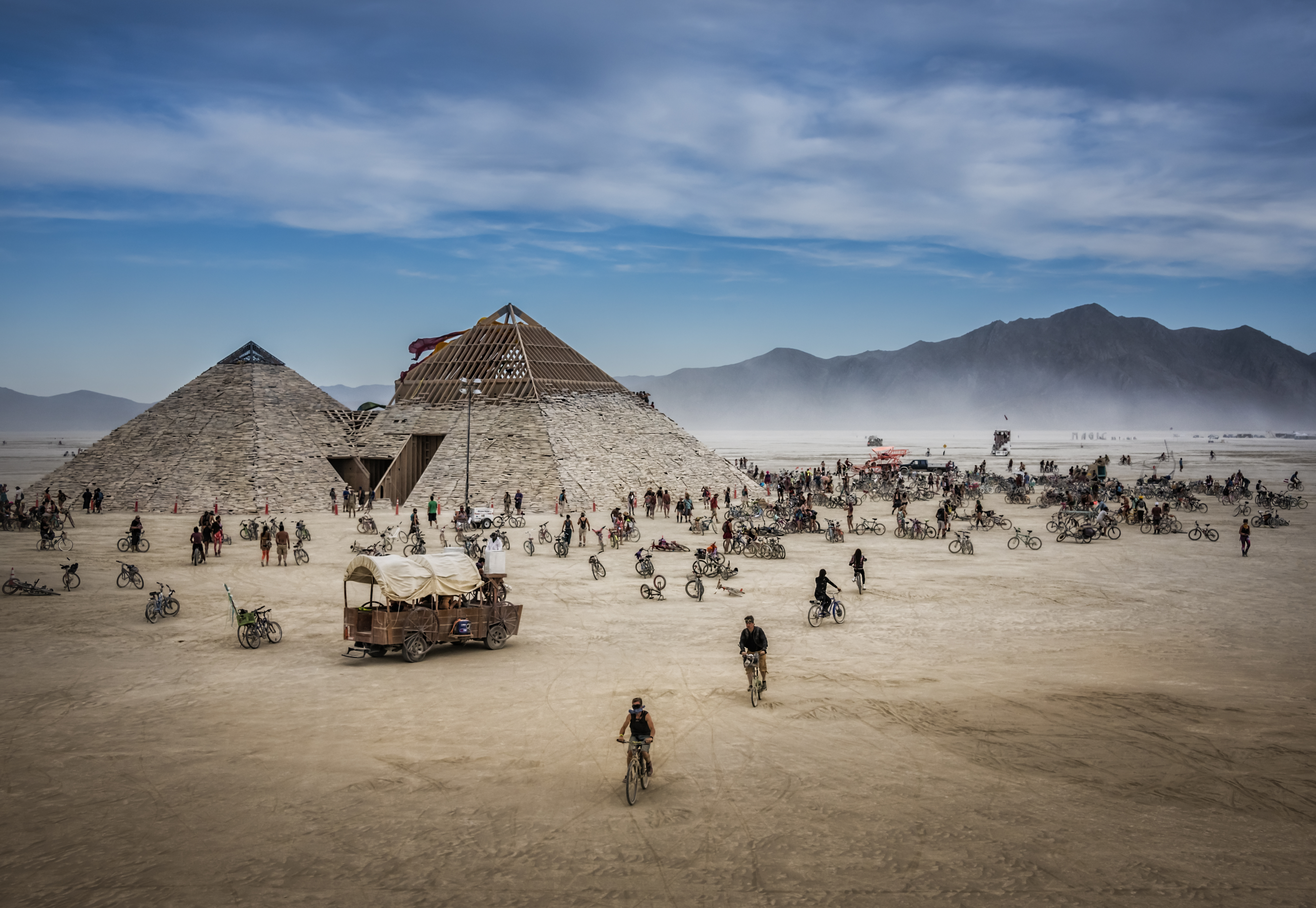
Burners on bikes approach the "Catacomb of Veils," an art piece created by Dan Sullivan for Burning Man 2016. Sullivan raised $68,012 on crowdfunding platform Indiegogo to help cover the project’s costs. Photo courtesy of Tom Stahl.
The bylaws for the new nonprofit were written with great care, to reinforce Burning Man’s Ten Principles: “radical inclusion,” “radical self-expression,” “radical self-reliance,” and all the ideas of gifting, decommodification, participation, environmentalism, and civic responsibility that underpin the annual gathering. For example, the bylaws state that sales during the event are barred from “excess benefit transactions” to prevent any future form of profiteering or commercialization at the yearly event. This is important because only two things are sold for “real-world money” during Burning Man — coffee and ice — and only the organizing body sells those things, so this bylaw protects the organization from eventually letting their incentives get away from them in the future while setting the prices on that coffee and ice.
To make the transition to a nonprofit, Burning Man’s co-founders collectively donated $7.114 million of the trademark’s market value back to BMP — which represents most of its independently appraised fair-market value. For their 30 years of largely unpaid service to Burning Man, each of the six original LLC partners received a modest $46,000 in compensation — serving as the ultimate act of “gifting.” Founders are employed by the BMP and compensated accordingly, but their employment is not guaranteed. However, the founders were granted lifetime seats on BMP’s Board of Directors, with the caveat that the new nonprofit required eleven or more disinterested directors to complement the six founders, intentionally diluting the founders’ voting power.
On an annual basis, revenue for the nonprofit will predominantly be derived from event ticket sales, which earned roughly $37.7 million in 2016. After it became a nonprofit, BMP hired a Director of Philanthropic Engagement to lead the organization’s fundraising efforts. In 2016, donors gave generously to fund the purchase of a permanent presence in northern Nevada, a private parcel of land and hot springs known as Fly Ranch. This was done to provide a year-round location near Black Rock City where the organization could experiment with and apply the Ten Principles 365 days a year. The donations to support Fly Ranch did boost contributed revenue for that one-time transaction, to 17.5 percent of total revenue for 2016. But in most years, contributed revenue has been much less, as most revenue is derived from earned revenue in the form of ticket sales.
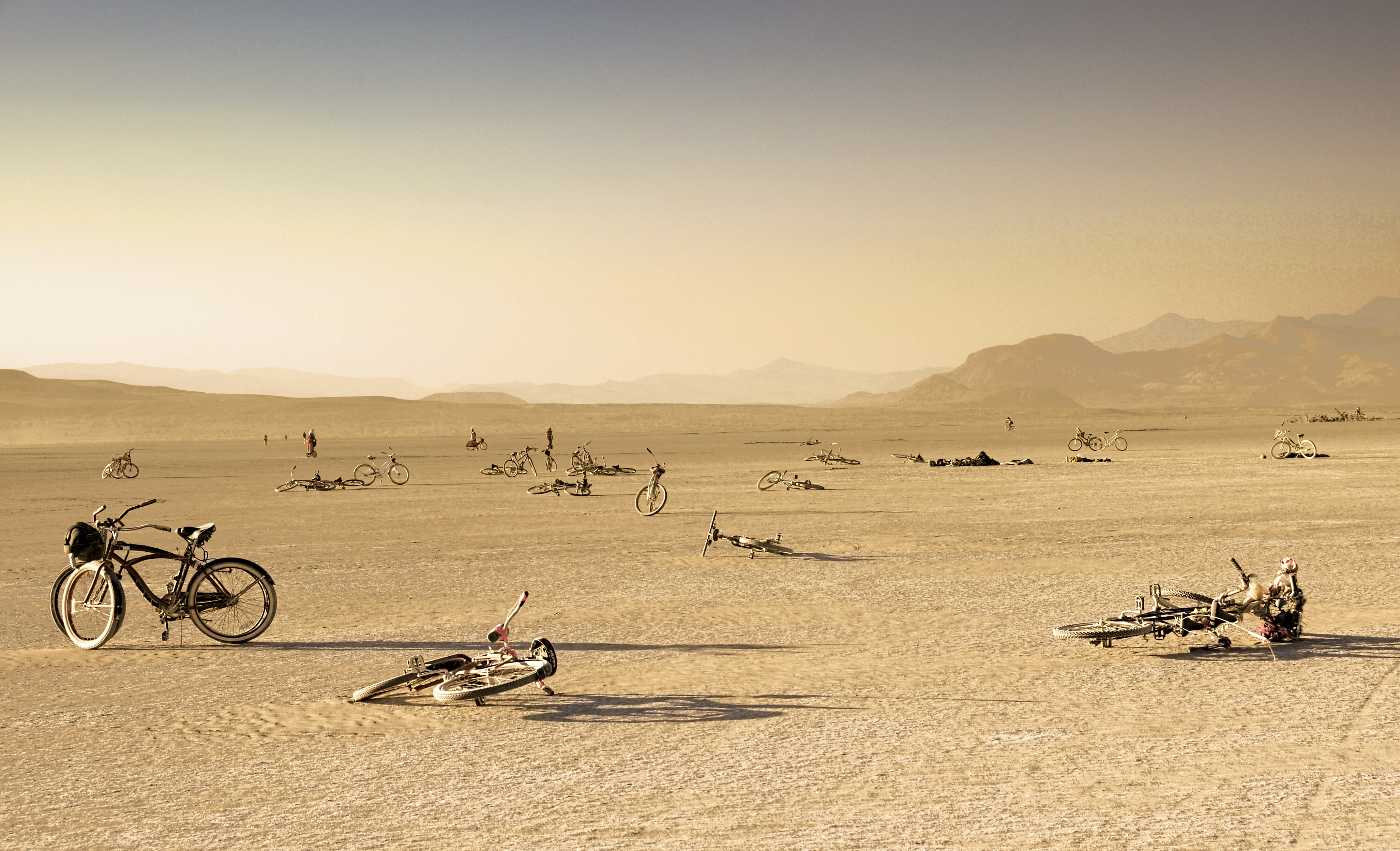
Abandoned bicycles left on the playa after Burning Man 2012. The website for the Burning Man Project says: “As a violation of Leave No Trace [one of the Ten Principles of Burning Man], abandoning a bicycle on the playa is just as offensive as leaving a pile of trash. Both require someone to remove the mess from the playa in order to return the Black Rock Desert to its natural state and satisfy the requirements of Burning Man’s permit from the Bureau of Land Management. In addition to hauling trash to landfills, in recent years Burning Man’s Department of Public Works has also been forced to spend time removing and dealing with large numbers of abandoned bicycles, some in perfect condition. Some have been recycled by participants who have lost bikes; either by misplacement or to thieves. Others became property of Gerlach High School and the Bike Hut (a not-for-profit bike cooperative in San Francisco).” The Burning Man site credits this statement to Ray Allen, who is listed as general counsel in their Staff section.
Photo courtesy of Tom Stahl.
Now, as BMP’s leadership sets its long-term strategy, a question remains: what percentage of total revenue should donations represent going forward? And are the people who are already so generous in giving their time also willing to give with their wallets? Yet these funds are much needed if BMP is to support its artists more fully and to grow globally.
As Theresa Duncan notes: “There’s a whole constellation of giving that takes place surrounding Black Rock City, which, if you participate in all the different ways that are available, could take years to do. [What with] participating in the regional network, or being a part of a camp, or creating a mutant vehicle, or building an art project, such that by the time you’ve gone through that constellation, you’ve already gifted so much … that giving a cash donation to the organization is not top of mind.” But even though cash isn’t top of mind, and the Burning Man event is a gift economy, these monetary considerations are critical. As Burning Man continues to grow, both inside and outside of Black Rock City, the organization faces a complex landscape of challenges and opportunities as well as a scarcity of resources.
For instance, is the partial art grant system sufficient for artists, or are there new ways to raise money for artists so that their art is fully funded? The art displayed at Burning Man can take a year for artists to create and can cost tens of thousands of dollars that they fully expect they will never get back (often, the art itself is constructed from expensive materials). As board member Jennifer Raiser affirms: “The thing that distinguishes Burning Man art is its sheer lack of parameters. The size of the art is as big as you can possibly manage to make, which requires collaboration because a single artist can’t build something that's 80 feet tall. And that requires resources and time to create wonder and, ultimately, a sense of community.”
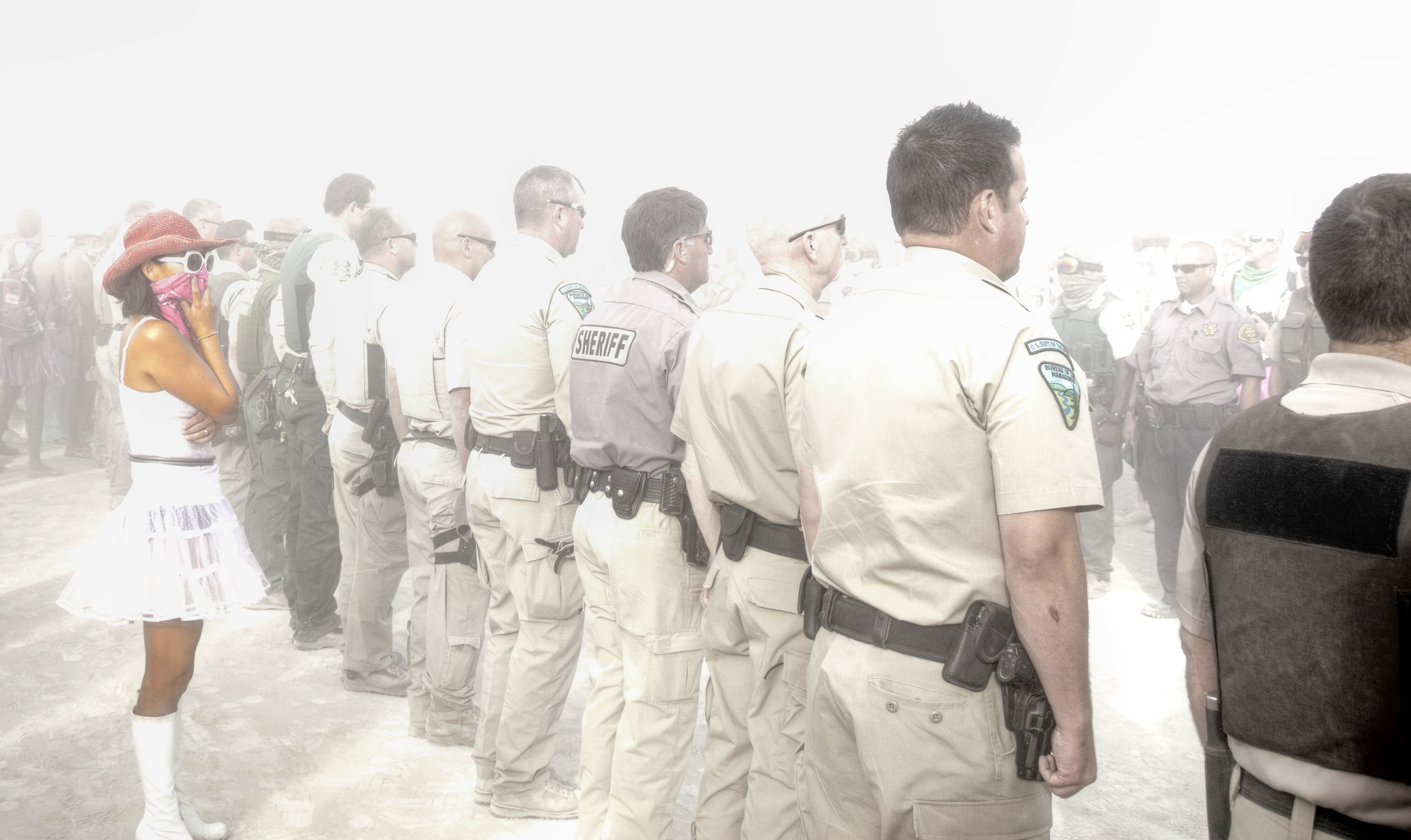
This photo was taken during a memorial service at the Burning Man Temple in 2013. The Temple is one of few recurring structures at the Burning Man event, and has hosted everything from weddings to funerals. In 2013, a group of law enforcement officers conducted a funeral for a fallen officer at the Temple, and many nearby Burners joined the funeral as well. After the 2013 event, a Burner named Jon Mitchell wrote on the Burning Man blog: “It had been a big year for run-ins with law enforcement on the playa. We had read plenty of stories about severe and surprising busts in the run-up to Burning Man, and we heard more tales of woe from friends after we arrived. The Bureau of Land Management had insisted on tighter control at the gate. It seemed like a good year to brush up on our rights….”
Mitchell writes that because of this atmosphere, he was initially upset to see law enforcement enter the Temple… until he realized they were there for a funeral. He writes about his reaction to that moment: “My mind buzzed with contradictions. I realized that this was some kind of memorial, which made perfect, beautiful sense. But I couldn’t quiet an angry voice in my mind, raving about Romans and Christians. Why are the forces of the state entering our Temple? I was trying so hard to parse it that I couldn’t concentrate on what was actually happening… until I heard the eulogy for Michael Dwayne Bolinger read out over the radio, and I saw the emotion well up in the faces of the federal agents surrounding me. Kind words were said, tears were shed…. We Burners were full of both fear and love. The BLM, the feds, the human beings in the gray trucks and the khaki uniforms, they were, too. We all stood like holy warriors on the same ground. As I worked hard in my heart to unify these opposing forces, I felt… no, I saw the Presence that underlies them both, presiding over our Temple rituals. I swear to God I did."
Photo courtesy of Tom Stahl.
Due to permit restrictions and concerns around transportation, Black Rock City’s population is currently capped by the Bureau of Land Management at 70,000 participants, with an additional 10,000 staff and volunteers. Given the physical limitations of one two-lane highway from Reno to Black Rock City, much of the future growth of Burning Man must take place beyond the playa.
While the founders are invited to speak at gatherings and conferences around the world, it is difficult to know how much influence these speaking engagements might have. As co-founder Crimson Rose states: “The biggest challenge is going to be cultural… we need to instill in everyone on the planet the will to live and survive and enjoy life, to have experiences… that’s what people do at Burning Man: have real experiences.” This leads the founders to ask if there is a more direct way to become forces for good and to influence business and society — and that may involve having access to resources and financial support, to grow the organization to reach and support many of the global events now happening year-round.
This year, for the first time, Burning Man went on without Larry Harvey. Based on my time with him, I sense that he would have wanted us to ask ourselves: how can this flame spark a sea change toward a more principled way of life, resulting in a better society and world for generations to come? At the event, I took a moment to reflect on the many ways Burning Man’s chief philosophic officer, Larry Harvey, influenced us all.
Special Note — You can get prints of these photos!:
Photographer Tom Stahl has donated several archival-quality prints of his Burning Man photos to The New Modality. You can buy one to help us get off the ground. They're available in our pre-order store (where you can also pre-order or subscribe to The New Modality in print). Any photo in this article is available in print form, plus there are more to choose from from Tom's archives.
— editor LL
Transparency Notes
This article was originally published in The Battery Candy. It is adapted from the Berkeley-Haas business school case study, “Burning Man: Moving from a For-Profit to a Nonprofit; the Ultimate Act of Gifting.” Copyright ©2018, by The Regents of the University of California. Reprinted/Adapted from the Berkeley Haas Case Series by permission of The Regents; to read the full case, visit their website.
As it happens, this article was edited by The New Modality editor in chief Lydia Laurenson when it was first published, because she used to be managing editor at The Battery Candy. So she can attest that when it was originally published, there was a light fact-check; since it was adapted from a case study previously published by Berkeley Haas, the article was not fact-checked when it was re-published. Captions were written by Lydia.
There's more about our transparency process at our page about truth and transparency at The New Modality.

